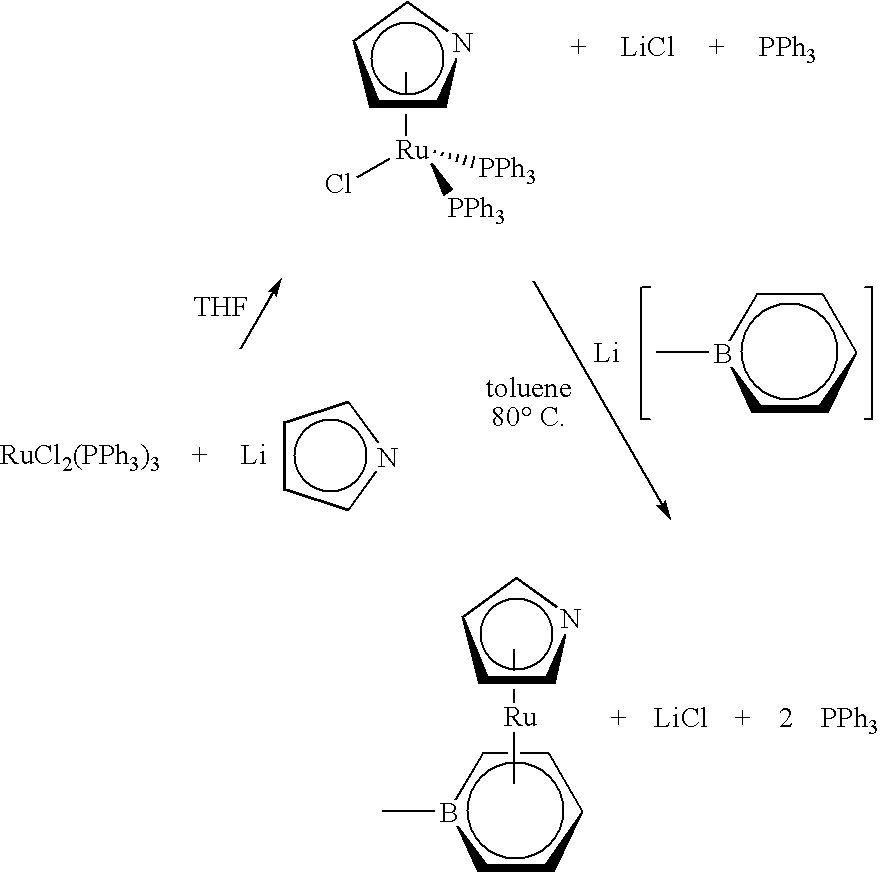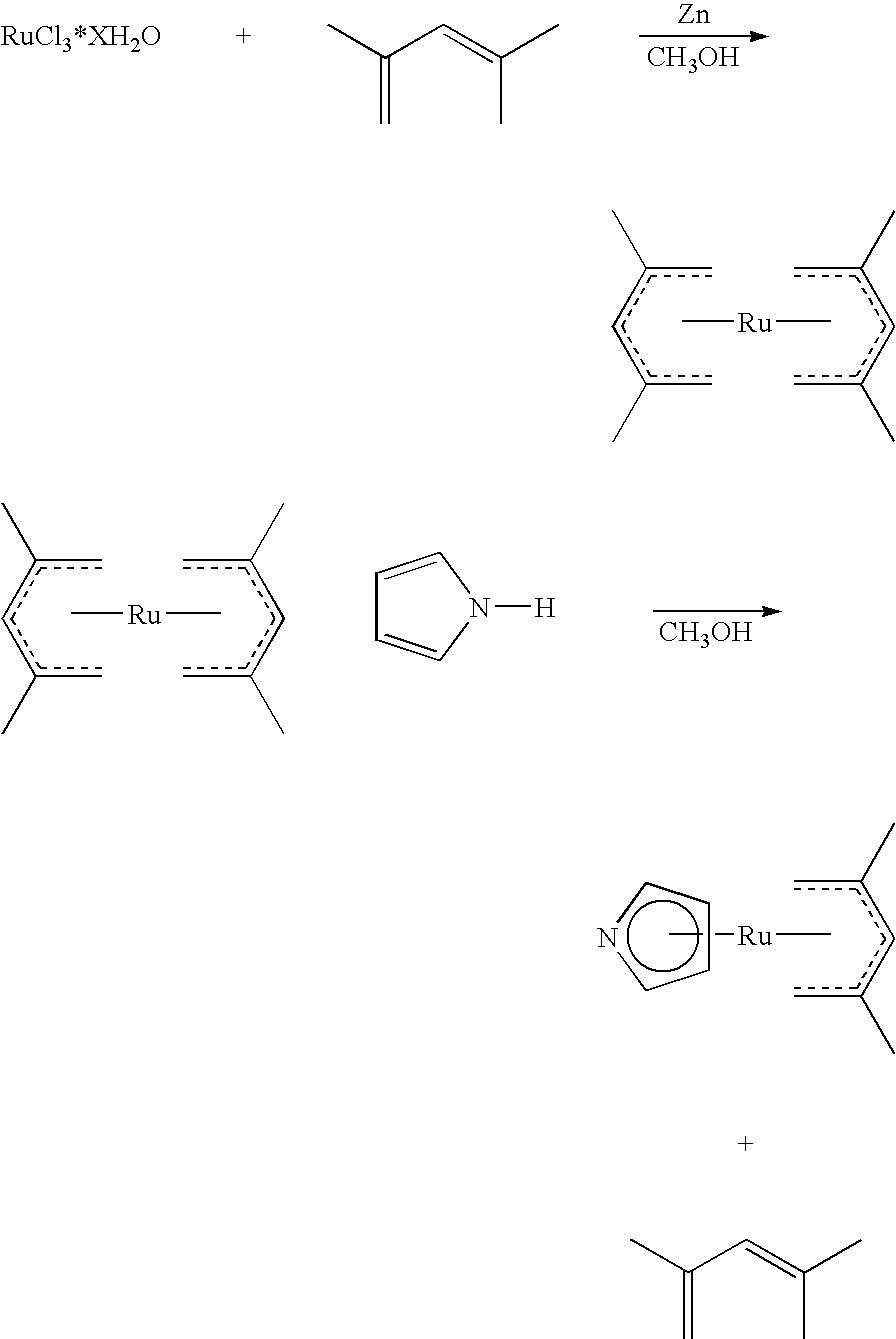Organometallic compounds, processes for the preparation thereof and methods of use thereof
- Summary
- Abstract
- Description
- Claims
- Application Information
AI Technical Summary
Benefits of technology
Problems solved by technology
Method used
Image
Examples
example 1
Synthesis of chloro(ethylcyclopentadienyl)bis(triphenylphosphine)ruthenium(II)
[0147]A 2 liter, three-necked, round bottomed flask was charged with a teflon stirring bar, ethanol (1.0 liter) and PPh3 (263 grams, 1.0 mol). A 250 milliliter dropping funnel, a 150 milliliter bath-jacketed dropping funnel, and a condenser were attached to the three necks of the 2 liter flask. Both dropping funnels were equipped with teflon valves that permitted their isolation from the atmosphere of the round-bottomed flask. A rubber septum was connected to the top of the 150 milliliter bath-jacketed dropping funnel. The top of the condenser was fitted with a T junction adapter and connected to an inert atmosphere. A heating mantle was placed beneath the 2 liter, three-necked, round-bottomed flask and the solution was stirred and heated to reflux. At reflux, all of the triphenylphosphine dissolved in the ethanol. The system was purged with nitrogen for 3 hours while at reflux.
[0148]While this was taking ...
example 2
Synthesis of (MeCp)(cycloheptadienyl)ruthenium
[0153]Chloro(methylcyclopentadienyl)bis(triphenylphosphine)ruthenium(II) was prepared in the same fashion as the ethyl derivative in Example 1 above.
[0154]A 3-necked, 250 milliliter, round bottomed flask is charged with chloro(methylcyclopentadienyl)bis(triphenylphosphine)ruthenium(II) (14.4 grams, 0.019 moles), a Teflon Stir bar and fitted with a reflux condenser, a glass stopper and a rubber septum. The contents of the flask are then connected to an argon / vacuum manifold and evacuated and backfilled with argon three times. Tetrahydrofuran (THF) (anhydrous, 150 milliliters) is then cannulated into the flask and stirring is initiated.
[0155]To this solution another solution, prepared in advance of, lithium cycloheptadienide (1.0 M in THF, 20 milliliters, 0.020 moles) is then cannulated into the reaction vessel over 5 minutes. Following the addition of this solution, the entire contents of the 250 milliliter flask are heated and stirred. T...
example 3
Synthesis of (EtCp)(methylboratabenzene)ruthenium
[0157]Chloro(ethylcyclopentadienyl)bis(triphenylphosphine)ruthenium(II) was prepared in the same fashion as described above in Example 1.
[0158]A 3-necked, 250 milliliter, roundbottomed flask is charged with chloro(ethylcyclopentadienyl)bis(triphenylphosphine)ruthenium(II) (15.2 grams, 0.020 moles), a Teflon Stir bar and fitted with a reflux condenser, a glass stopper and a rubber septum. The contents of the flask are then connected to an argon / vacuum manifold and evacuated and backfilled with argon three times. Tetrahydrofuran (THF) (anhydrous, 150 milliliters) is then cannulated into the flask and stirring is initiated.
[0159]To this solution another solution, prepared in advance of, lithium methylboratabenzene (1.0 M in THF, 20 milliliters, 0.020 moles) is then cannulated into the reaction vessel over 5 minutes. Following the addition of this solution, the entire contents of the 250 milliliter flask are heated and stirred. The soluti...
PUM
 Login to View More
Login to View More Abstract
Description
Claims
Application Information
 Login to View More
Login to View More - R&D
- Intellectual Property
- Life Sciences
- Materials
- Tech Scout
- Unparalleled Data Quality
- Higher Quality Content
- 60% Fewer Hallucinations
Browse by: Latest US Patents, China's latest patents, Technical Efficacy Thesaurus, Application Domain, Technology Topic, Popular Technical Reports.
© 2025 PatSnap. All rights reserved.Legal|Privacy policy|Modern Slavery Act Transparency Statement|Sitemap|About US| Contact US: help@patsnap.com



